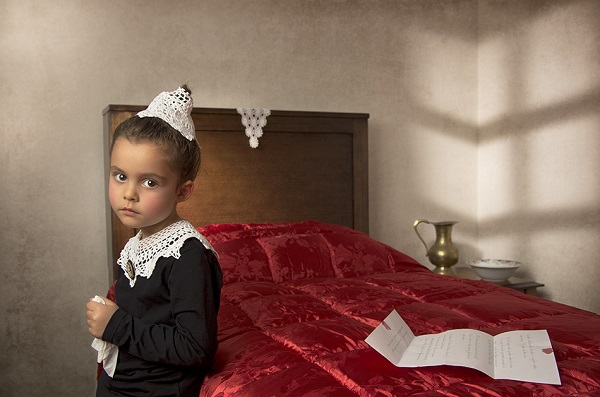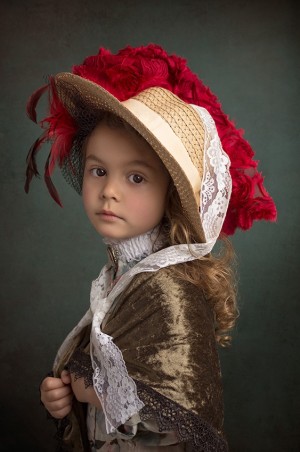Artist of the Week 3/6-3/12: Bill Gekas Captures Emotion within Storytelling Scenes of Children’s Portraiture
A camera lens sheds light on a story, anchored on a character’s emotion, notes acclaimed photographer Bill Gekas. Portraying one’s expressions can be a “reflection of moments in everyday life,” the self-taught virtuoso from Melbourne, Australia further expounds. Several of Gekas’ vintage and modern photos of his adorable five-year-old daughter are a mirror, silently reflecting on his love for her. His quest to discover her “right expressive moment” whisks him into a scene, and the need to capture that keeps him grounded; this process immensely piques his interest while inspiring insight and revelations.
“Portraits in general are fascinating,” he says, “as I find them to be more the study of a character than just a visual representation.” Producing an interpretation — and discussion — worthy photo takes technical and creative skill, developed and crafted over time.
In the mid-1990s, Gekas first used a 35mm film SLR camera as the brush to paint the emotionally nuanced strokes forming his absorbing photos. He got acquainted with photography’s technical aspects. Then, Gekas gravitated to digital cameras, infusing more sophistication into his work. What resulted are sublime visuals celebrated the world over. (Just last year, he garnered a ‘first place’ gold, three silver and three bronze awards, respectively, from the International Loupe Awards. It was a prestigious honor that means a lot to him.)
Resonating with multiple audiences, his portrait art focuses on aesthetics; he adds in an ounce of whimsy to a few images featuring his daughter. Gekas had a renewed purpose that developed over elapsed hours. “As a little time went on, I was still shooting and it became a more comprehensive body of work, which both my peers and the public found appealing,” he said. “This was the point where it ceased being a portrait of my daughter, but more a portrait of a child portraying a universal child.” The series, which began in 2010, evolved from “emotive-type photos” into a formative body of work. His photogenic daughter was a muse, channeling the “ethereal aesthetic” in classical recreations of great works, and contemporary images of childhood jubilation and imaginations. She gives a palpable, absorbing stare in The Scholar, an old-world, evocative image of her dressed in what appears to be Shakespearean clothing while sitting at a desk with a notebook on stand, written pages in script, and feather pen in ink bottle. Alternatively, she epitomizes innocence in the candid Grit & Glam, with her brown tousled locks, magical brown eyes and hand over her mouth. The shoots only last for 10 minutes every few weeks, Gekas said, so that his daughter has lots of time to be a child, and looks forward to dressing up in costumes during shoots.
Gekas steps from behind the camera to talk about the dichotomous, well-balanced series peppered with Dutch influences, and shares introspections on photography as an art form.

The Scholar by Australian photographer Bill Gekas. Photo Credit/Courtesy of: Bill Gekas.
GALO: These spellbinding portraits show your beautiful daughter in two dynamic worlds: one displaying her playful innocence in contemporary settings, and another fraught with nostalgia in recreated period paintings. Please tell us about discovering this dichotomous world of children’s portraiture.
Bill Gekas: I’ve found that when it comes to children’s portraiture, the scope of creativity can always be taken up a few notches; the dichotomous worlds can be emphasized without upsetting the realm of reality. Children can portray the different personalities that we have as adults, and this contrast can be a type of reflection of our own personalities. By portraying the classical and the more contemporary, we are playing with both extremities, which allow our minds to fill the gap in between; this is huge, but does not necessarily need to be made obvious.
GALO: Ruminating about that dichotomy, some pictures feel like the result of your casual observation, and/or a carefully developed idea. Is that safe to say? Is there another way in which your tagline — “imagination meets creation” — manifests within your portraits?
BG: Absolutely, the casual observation is the emotive aspect coming from her; the ideas and scene are always developed and thought out afterward. Having a deep respect for the works of the old masters has influenced me in how the general scene and atmosphere is thought out. My tagline, “imagination meets creation” is really the key, for nothing is left to chance during the creation process. It is all to an extent pre-visualized in my mind days or weeks before any of the other technical [details] are planned and executed.

Potatoes by Australian photographer Bill Gekas. Photo Credit/ Courtesy of: Bill Gekas.
GALO: Please expound on this creative process, including how your sketchbook becomes a vehicle for turning your ideas into beguiling photos?
BG: My rough sketchbook, with ideas and scribbled notes, is my reference point for many of my works. But there is a step before the sketchbook: ideas come across my mind by seeing or hearing something I found appealing, studying other artworks in different mediums (I can see an element in them which I can incorporate or twist it in order to fit into my perception of what is an ideal aesthetic). I’m no stranger to taking elements from other works, which I have seen, and molding them into my own works. I believe this is how art keeps evolving; as artists, we’re sort of more than just creators of artworks, but creators of art styles, which are constantly evolving.

The Letter by Australian photographer Bill Gekas. Photo Credit/ Courtesy of: Bill Gekas.
GALO: The Letter features your daughter in a black dress — with white trim around the collar — holding a napkin next to an unfolded letter in an “18th century Dutch-styled bedroom.” Using a cookaloris (cookie) for the first time to give the impression that your daughter is facing a window creates a poignant and striking photo. This “lighting experience” was about overcoming challenges, according to your blog. In retrospection, are there any other self-discoveries or lessons?
BG: Usually, some of the encountered challenges with this stylistic approach are the technical aspects. My image The Letter is one example of a challenge: emptying my daughter’s bedroom to recreate a minimalist room from a past era. [We had] limited space. I had a softbox for a light modifier; although, I knew the theory behind using a cookaloris for the window effect on the opposite wall, it was a shoot where I had to test the theory behind it just minutes before the shoot. Fortunately, this isn’t the norm when it comes to a majority of my shoots. In most cases, the lighting techniques I use are tried and proven beforehand in other shoots I‘ve done. Like all other shoots, I’ve discovered that a photographic shoot is more about problem solving and compromises than art direction and cool toys!
(Article continued on next page)

